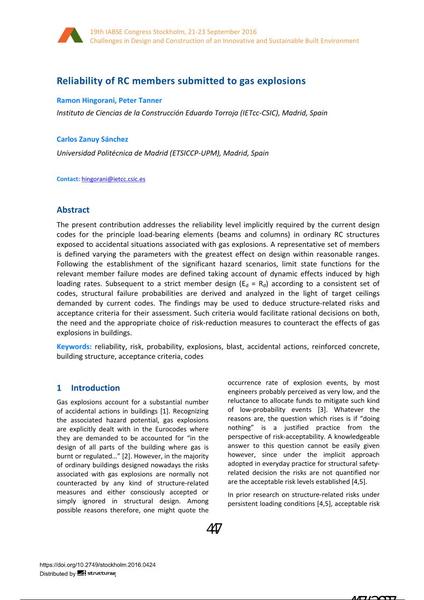Reliability of RC members submitted to gas explosions

|
|
|||||||||||
Bibliographic Details
| Author(s): |
Ramón Hingorani
(Instituto de Ciencias de la Construcción Eduardo Torroja (IETcc-CSIC), Madrid, Spain)
Peter Tanner Carlos Zanuy (Universidad Politécnica de Madrid (ETSICCP-UPM), Madrid, Spain) |
||||
|---|---|---|---|---|---|
| Medium: | conference paper | ||||
| Language(s): | English | ||||
| Conference: | IABSE Congress: Challenges in Design and Construction of an Innovative and Sustainable Built Environment, Stockholm, Sweden, 21-23 September 2016 | ||||
| Published in: | IABSE Congress Stockholm, 2016 | ||||
|
|||||
| Page(s): | 447-455 | ||||
| Total no. of pages: | 9 | ||||
| Year: | 2016 | ||||
| DOI: | 10.2749/stockholm.2016.0424 | ||||
| Abstract: |
The present contribution addresses the reliability level implicitly required by the current design codes for the principle load-bearing elements (beams and columns) in ordinary RC structures exposed to accidental situations associated with gas explosions. A representative set of members is defined varying the parameters with the greatest effect on design within reasonable ranges. Following the establishment of the significant hazard scenarios, limit state functions for the relevant member failure modes are defined taking account of dynamic effects induced by high loading rates. Subsequent to a strict member design (Ed = Rd) according to a consistent set of codes, structural failure probabilities are derived and analyzed in the light of target ceilings demanded by current codes. The findings may be used to deduce structure-related risks and acceptance criteria for their assessment. Such criteria would facilitate rational decisions on both, the need and the appropriate choice of risk-reduction measures to counteract the effects of gas explosions in buildings. |
||||
| Keywords: |
reliability blast reinforced concrete risk acceptance criteria codes probability building structure explosions accidental actions
|
||||
